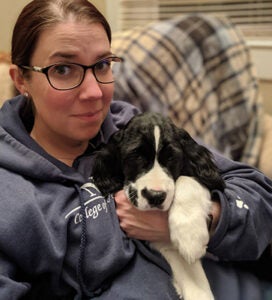
Breeders hope that their dam will be able to provide for all her puppies, but sometimes she needs help. Even the strongest and best prepared bitch may not be able to meet the nutritional requirements of a large litter without risk to her or her puppies’ health.
And in any size litter, there might be a puppy who isn’t quite as strong as the others and needs a little extra help getting the nutrition needed to grow to full potential.
Dr. Kate Bremser DVM is a breeder of English Springer Spaniels. She has provided answers to some important questions breeders might have about supplementing puppies.
What decisions should breeders consider when deciding whether to supplement or not?
Bremser: Deciding when to supplement can be a tricky thing. Broadly, you might want to consider supplementing if:
- Your litter is very large, and you have more puppies than your dam has nipples.
- You have a puppy with a cleft palate or other nursing impediment.
- Your dam is a nervous first-time mother struggling to let puppies nurse.
- There is illness in the dam such as metritis or mastitis, death of a dam, inadequate milk supply, etc.

All breeders should be weighing puppies frequently to ensure that they are gaining weight. I believe the best practice for this is to weigh them at birth (before first nursing), then twice daily at the same time each day thereafter. Puppies should be gaining readily and quickly; any that are stalled out or losing should be considered for supplemental feeding.
It is not unusual for puppies to lose or not gain for the first 24 hours or so while the dam’s milk comes in, but after that they should start gaining rapidly. Any puppies that are lagging behind or not gaining should be observed closely to ensure that they are properly nursing before deciding if they need supplemental feeding. They should be latching and suckling vigorously, with little to no milk coming back out of the nose. If puppies are latching well but not gaining, I would absolutely start supplementation.
I have had to supplement a couple of litters here and there for various reasons. Once I had a puppy with a malformation to his mandible, making it hard for him to latch and create suction to nurse. He had an easier time with the bottle so while he was allowed to continue nursing normally with his siblings, I also bottle-fed him. Another time I had a litter of nine, and the dam just wasn’t making enough milk for them in the first few days. It can sometimes take several days for milk production to really ramp up, so I bottle-fed that litter in addition to nursing for the first five days. After that, they were able to get all they needed from the dam, so I was then able to stop.
Most recently, I had a litter that developed some GI issues at around day seven. They really didn’t feel well and were lethargic. As a result, they weren’t seeking out their dam to nurse. I chose to tube feed those puppies because it was imperative that they receive enough calories so that they could get over their stomach upset. In that case, I was able to supplement for only a few days while they recovered then they resumed nursing normally.

How can breeders find the best formula for puppies?
Bremser: I think the best formula choices for puppies are either a commercially available prepared formula such as Esbilac or a published recipe by repro guru Myra Savant Harris – the one I tend to use for my own puppies and they do quite well on it. It is important to remember that not all puppies will thrive on the same formula, so if things aren’t going well with supplemented puppies, it is sometimes useful to have a backup plan. Here is the formula I use and which can also be found on her website.
Ingredients:
- One can of evaporated goat’s milk, undiluted (You can substitute evaporated cow’s milk if you can’t find the goat’s milk)
- One cup of full-fat yogurt (the fattiest and freshest you can find)
- 2 raw egg yolks (don’t worry about the raw eggs)
- 1/3 cup of freshly made, strong liver broth made from boiling a piece of liver in one cup of water and then reducing the water to 1/3. You can substitute fresh beef broth if you just can’t tolerate the smell of liver, but the liver is much better. Don’t eliminate the broth.
- 1 Tablespoon of Virgin Olive Oil (you can use mayonnaise if you like, but remember it is acid based)
- 1 teaspoon of Karo or corn syrup
- 1 dropper full of baby vitamin that doesn’t contain iron
Directions:
Place it all in a blender, blend then pour into ice cube trays and freeze. Once frozen, store the ice cubes in a plastic bag and take out how many you need for a feeding; thaw and warm to about 100 degrees. It’s good in the freezer for a full year. If you are going to use this for bottle-feeding or Adele’s sponge feeding technique, you may need to thin it with a little bit of Pedialyte.
The advantage of this formula is that it has been formulated to contain 3-4 times the calorie content of breast milk. Mother’s milk has 3-4 calories per cc. This formula has 10-12 calories per cc. The reason for using the evaporated milk without diluting is to get extra calories, same with the full fat yogurt and the olive oil. It is all about calories. Your puppy will gain weight on this formula beginning about 48 hours after beginning to feed on the formula. Feed the puppy one cc (a ml is identical to a cc) of formula for every ounce of body weight every 3-4 hours or when crying from hunger. Self-regulated bottle feeders may eat more at every feeding and want to eat less often. This is fine too.
What are some of the best tools to use to feed puppies?
Bremser: There are several options: bottle feed, sponge feed, or tube feed. For bottle feeding I personally like the Dr. Brown’s infant bottles with the 0 or preemie nipples. For my breed (English Springer Spaniels), this is a good size nipple. For much larger or smaller breeds, it may not be the right size though, so in that case, sponge feeding or tube feeding may be a better option. For sponge feeding, I use a regular makeup sponge (the wedge kind) and cut a small hole into the wide end. Insert your syringe and push the formula slowly through the sponge allowing the puppy to suckle off the narrow end. Tube feeding is fast and effective but takes a practiced hand. For that, you will need a red rubber catheter or feeding tube, a coffee mug to prop the puppies up in, and appropriately sized syringes.
With tube feeding, it is imperative that someone familiar with how to do it safely teaches you and can help you hold and feed for the first few times. There are some good instructional videos on the Myra Savant Harris website, as well on feeding techniques. It is important to remember that any time we are supplementing puppies the risk of aspiration pneumonia rises. Make sure to feed them slowly, monitoring how much they take in so that you can avoid overfeeding. Also, if bottle or sponge feeding puppies, they should be lying on their stomachs with their front feet and chest propped up on a towel to simulate a normal nursing position. If tube feeding, I find it best to sit them upright (hence the coffee mug) as gravity helps the formula stay in the stomach.

How long should puppies typically be hand-fed until they can be weaned?
Bremser: Puppies should be hand-fed until they are approximately 3 weeks of age and can be weaned onto puppy mush. My favorite combination for that is to mix some of the formula I had been feeding them with into some of the Royal Canin Puppy Starter Mousse. Puppies generally take right to eating that pretty well as it is easy for them to start lapping it up. It is imperative to continue weighing puppies through this transition so that you can quickly identify any individuals that are not consuming enough calories.
Preparation is crucial. It is always better not to need these supplies because a dam’s delivery and lactation went well, but breeders should have on-hand supplies necessary for supplementing newborns, well before the due date.
There are new devices available that can make it easier for breeders to supplement puppies a few at a time. A safer and more natural option than tube feeding, and more efficient than bottle feeding one puppy at a time, are the Surro-pooch nurser or a silicone puppy nursing station. These should be used with supervision.

